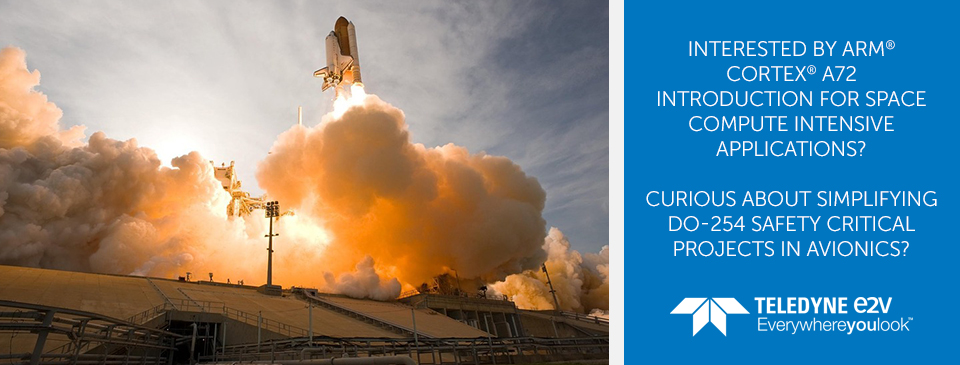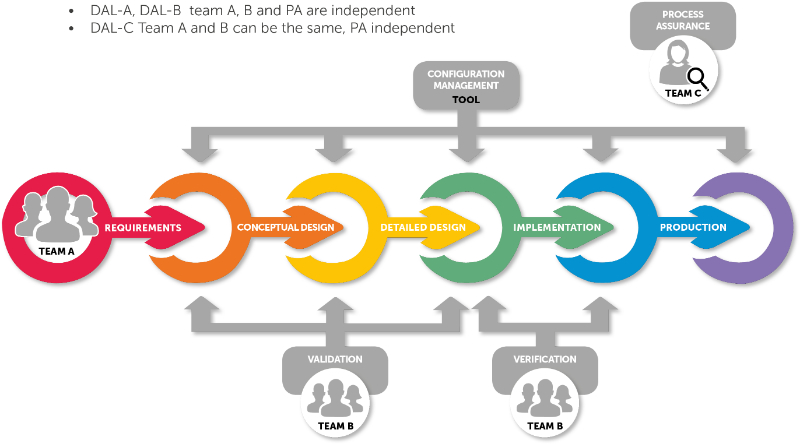
In space compute intensive applications, the current trend we observe in most of the ecosystem is the following: how could one perform very complex and powerful data processing into space while ensuring at the same time a decent level of radiation tolerance and a reduced payload SWaP (Size, Weight & Power, translating here at least in a limited power consumption of the computing platform)? Adding to this either significant space heritage or at least sufficient advantages and mitigated risks to be convincing for space systems designers.
Teledyne e2v, with its long experience in designing, qualifying and shipping Radiation Tolerant Space Processors, is introducing two ARM® based compute intensive Microprocessor solutions for space applications, such as payloads and beyond:

The rationale for embedding more powerful data processing solutions in space may be one of the following:
Teledyne e2v foresees an interest among the following space applications:
 LEO (Low Earth Orbit), GEO (Geostationary Orbit) as well as manned space missions would find some interests in those new solutions.
LEO (Low Earth Orbit), GEO (Geostationary Orbit) as well as manned space missions would find some interests in those new solutions.
Multiple benefits can be listed by bringing ARM based microprocessor solutions into space:
With Qormino Radiation Tolerant Common Compute Platform, customers will not only benefit from its compute intensive capabilities, but also enjoy Time To Market advantages, thanks to the DDR4 connection already integrated on the product.
Further to this, Qormino is also available as a complete platform, with reference & development platforms, as well as an ecosystem of partners.
Zoom into Teledyne e2v Space Qualification Flows:
Teledyne e2v offers today two types of Radiation Tolerant Space Microprocessors:
Both families are following long and complex Teledyne e2v Space Qualification steps. Please click if you would like to learn more about our Space Qualification Flows and receive a free poster!
The main difference between families is that Ceramic Non Hermetic Flip Chip Solutions follows QML-Y standard (robust ceramic packaging handled by Teledyne e2v from a bare die, with columning options), while the Organic Package Solutions are Commercial devices up-screened and following ECSS / NASA Space Qualification.
Teledyne e2v’s Radiation Tolerant Space Microprocessor portfolio features currently four radiation tolerant devices with shipment and flight heritage:
RTCA/DO-254, Design Assurance Guidance for Airborne Electronic Hardware is a document providing guidance for the development of airborne electronic hardware, published by RTCA, Incorporated.
DO-254 standard provides a structured development process to design a simple or complex hardware system of an avionic system. This standard allows in particular the use of different types of complex or simple COTS devices (Component Off The Shelf), therefore such components may be part of a commercial avionics system and environment. Several safety levels of the system are defined, called DAL (Development Assurance Level). The five different safety critical levels run from A (most critical level: catastrophic in case of system failure) to E (no important impact on the flight).
Teledyne e2v Qormino Common Compute Platform solutions
Teledyne e2v has been naturally involved in DO-254 on its Qormino® solutions, thanks to an extensive experience in selling Hi Reliability Microprocessors for more than 30 years to Aerospace & Defense markets.
Qormino is a smart, small and powerful Common Computer Platform concept from Teledyne e2v designed to respond to SWaP constraints (Size, Weight and Power).
Current portfolio includes:
Teledyne e2v is also working on custom models of the platform, with different configurations of microprocessor and/or memory.
Qormino key value points:
Qormino is perfectly suited for Avionics applications, but its advantages go far beyond, such as Networking applications, Scientific, Defense & Industrial applications. Qormino supports Linux as well as most of the RTOS (Real Time Operating Systems) of the market.
DO-254 Development methodology
DO-254 offers a methodology to follow in order to develop a system (specifications, requirements, validation and verification, design reports…). To make the development process run smoothly, different independent teams should be involved.
All specifications must be covered by a list of requirements to meet the DO-254 standard:
A Configuration management should also be set up at all stages of this process in order to identify and track any updates or development modifications, to manage the baseline (releases and archives) and to handle the problem and bug report. Finally, the Process Assurance should be set up by an independent team to organize an audit and demonstrate compliance to DO-254 standard.

In addition to the DO-254 certification, a complementary document (the EASA Certification Memorandum SWEH001) is available and provides a guideline for the use of COTS. This guideline explains how to follow targeted DALs and the Product Service Experience (flight heritage) by completing up to 16 activities.
The result of these activities should be compiled into another document: The Electronic Component Management Report (ECMR). This document is provided to the certification authority to prove the system follows all the rules and guideline required by the EASA Certification Memorandum. On demand, the system applicant shall be able to provide all the documentations, plans, reports to prove he follows the process defined by DO-254.